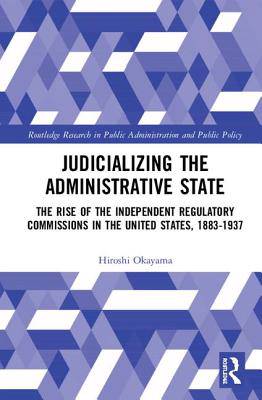
- Afhalen na 1 uur in een winkel met voorraad
- Gratis thuislevering in België vanaf € 30
- Ruim aanbod met 7 miljoen producten
- Afhalen na 1 uur in een winkel met voorraad
- Gratis thuislevering in België vanaf € 30
- Ruim aanbod met 7 miljoen producten
Judicializing the Administrative State
The Rise of the Independent Regulatory Commissions in the United States, 1883-1937
Hiroshi OkayamaOmschrijving
A basic feature of the modern US administrative state taken for granted by legal scholars but neglected by political scientists and historians is its strong judiciality. Formal, or court-like, adjudication was the primary method of first-order agency policy making during the first half of the twentieth century. Even today, most US administrative agencies hire administrative law judges and other adjudicators conducting hearings using formal procedures autonomously from the agency head. No other industrialized democracy has even come close to experiencing the systematic state judicialization that took place in the United States.
Why did the American administrative state become highly judicialized, rather than developing a more efficiency-oriented Weberian bureaucracy? Legal scholars argue that lawyers as a profession imposed the judicial procedures they were the most familiar with on agencies. But this explanation fails to show why the judicialization took place only in the United States at the time it did. Okayama demonstrates that the American institutional combination of common law and the presidential system favored policy implementation through formal procedures by autonomous agencies and that it induced the creation and development of independent regulatory commissions explicitly modeled after courts from the late nineteenth century. These commissions judicialized the state not only through their proliferation but also through the diffusion of their formal procedures to executive agencies over the next half century, which led to a highly fairness-oriented administrative state.
Specificaties
Betrokkenen
- Auteur(s):
- Uitgeverij:
Inhoud
- Aantal bladzijden:
- 188
- Taal:
- Engels
- Reeks:
Eigenschappen
- Productcode (EAN):
- 9781138306653
- Verschijningsdatum:
- 15/05/2019
- Uitvoering:
- Hardcover
- Formaat:
- Genaaid
- Afmetingen:
- 156 mm x 234 mm
- Gewicht:
- 458 g

Alleen bij Standaard Boekhandel
Beoordelingen
We publiceren alleen reviews die voldoen aan de voorwaarden voor reviews. Bekijk onze voorwaarden voor reviews.









